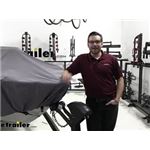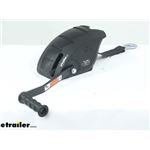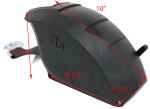Dutton-Lainson Covered Hand Winch - Single Speed - Freewheel - 20' Strap - 1,500 lbs

 Arrives before Christmas
Arrives before Christmas 

Thank you! Your comment has been submitted successfully. You should be able to view your question/comment here within a few days.
Error submitting comment. Please try again momentarily.
- All Info
- Reviews (18)
- Q & A (0)
- Videos (2)
- Photos
Dutton-Lainson Trailer Winch - DL17027
- Boat Trailer Winch
- Utility Winch
- Standard Hand Winch
- 1001 - 2000 lbs
- Polyester Strap
- Single Speed Winch
- Dutton-Lainson
- Ratcheting Hand Crank
Hand winch is perfect for marine use and other applications that require horizontal pull. Freewheel lets you manually control strap pay out, and a covered ratchet pawl locks load in place. Cover protects internal components from water damage.
Features:
- Heavy-duty, single-speed hand winch is designed for horizontal pulling applications
- Perfect for loading boats onto your trailer and maneuvering bulky equipment
- Designed to pull objects up to 1,500 lbs
- Freewheel mode lets you manually control strap payout
- Covered ratchet pawl locks load in place when handle stops cranking to prevent unintentional payout
- Ratchet can be flipped so you can crank strap from bottom of reel
- 20' Polyester strap with hook is strong and abrasion resistant
- Hard plastic, 3-piece cover protects all internal components from dirt and water
- Zinc TUFFPLATE finish is corrosion resistant
- Textured gray powder coat finish on base helps prevent rust
- Deluxe, all-black handle has soft and comfortable grip
- Mounting plate (sold separately) lets you install winch on your boat trailer or other stable surface
- (3) 3/8" Bolts (sold separately) required for installation
- Made in the USA
Specs:
- Rated line pull (with 1 layer of strap around the reel):
- Static load: 1,500 lbs
- Rolling load: 15,000 lbs
- Boat pull capacity:
- Trailer with wooden bunks and no self-alignment capability: 1,500 lbs
- Standard trailer: 3,000 lbs
- Trailer equipped with free-turning rollers: 4,500 lbs
- Handle arm length: 9-1/2"
- Reel hub diameter: 7/8"
- Gear ratio: 4:4:1
- 5-Year limited warranty
Note: Winches are not to be used as hoists for lifting, supporting or transporting people, or for loads over areas where people can be present.
Rolling Load Winch Capacity
| Percent Incline | Rolling Load Capacity (lbs) |
|---|---|
| Level Surface | 15,000 |
| 5 (3°) | 10,000 |
| 10 (6°) | 7,530 |
| 20 (11°) | 5,100 |
| 30 (17°) | 3,915 |
| 50 (26°) | 2,790 |
| 70 (35°) | 2,295 |
| 100 (45°) | 1,935 |

To calculate your winch's rolling load capacity - the amount of weight it can pull up an incline - you must multiply the line pull capacity by a factor determined by the degree of the incline.
The multiplication factors shown in the chart, right, include a 10-percent rolling friction factor.
Note: A 5-percent - or 3-degree - incline is a 1/2' rise over a 10' distance. Follow the chart to determine your winch's rolling load capacity.
17027 Dutton-Lainson Hand Winch - TUFFPLATE Finish - 1 Speed - Reversible Ratchet Pawl - 1,500 lbs
Model Number: DLx1500FC


Videos are provided as a guide only. Refer to manufacturer installation instructions and specs for complete information.
Video Transcript for Dutton-Lainson Covered Hand Winch Review
Hey, everybody. Welcome to etrailer.com. I'm Bobby, and today we're taking a look at the Dutton-Lainson Single-speed Hand Winch with a 1,500 pound weight capacity rating. Now what's excellent about this guy, it's gonna make it really easy to get those hay bales, those boats, whatever we might be hauling, of course, on this horizontal pull. Now this guy is gonna be covered. So there's a couple things to keep in mind.
Why I really mentioned that horizontal pull, because do you have this on a vertical posting, much like on a boat trailer, this can start interacting with this outer covering and without having to take it off, you're gonna start seeing a little bit of contact there with your strap and your housing that can lead to your housing cracking or deterioration on your strap. So let's make sure we are doing a good job of not having interaction by making sure we only have a horizontal pull. So if you guys are looking for this in minds, or keeping in mind kind of hauling boats and towing boats, well, how do we do that, right Which capacity is right for us or which winch is right. Well, how do we find that Well, the big thing is gonna be, the biggest factor, how heavy our boat is. So we have a 2,400 pound boat here today.
Hopefully we already know it at home. There's gonna be a couple of ways of finding it out. If we don't though big one's gonna be, we got us some stickers there on our boat, letting us know a lot of times what our gross boat weight is. Of course let's keep in mind we need to factor in equipment and the gas, even in our engine, especially if we're taking out our boat and trailer, we're ready to get in the water right away. And then once we actually have found that weight, we gotta keep in mind that the capacity of our winch needs to be at least half of the capacity of the total weight of our boat and equipment.
So if you have a 2,000 pound boat, you're gonna need a 1,000 pound weight capacity on your winch. However, with that being said, I personally recommend you at least get three quarters of your total boat weights to that capacity of your winch. So if you've got a 2,000 pound boat, looking at a 1,500 pound winch, just like you're seeing here today. Now we do have a 2,400 pound boat. So we are just gonna be putting ourselves right in that green zone, right between that half and that three quarters weight.
Things are running into that though. You are getting a little bit less of a safe connection. You are putting more strain on your winch, but the biggest thing is gonna be that convenience. It's gonna be harder and more difficult if we are underrated on our winch. And it's always gonna be a safer bet to go just a little bit higher. And what's nice is it really doesn't break the bank to have to do that. We're not talking about hundreds of dollars. We're just talking about a leg up, that's gonna make our life that much more convenient. So we are working on a covered winch here today. Now that's gonna compose just a couple little things. A, can be really easy to actually move this housing, and we're gonna give you guys a good look at that in the install, basically just have little set screws here that walk this out. Now it is in three pieces as well as we actually have our side plates too. Now that makes maintenance a little bit harder, right We kinda have to get those plates out of the way if we wanna serve this for broken parts, deterioration, those sort of things that are gonna be happening years down the line, hopefully. But with that being said, the covered aspect is also to prevent any kind of debris from getting inside of our winch. So it's gonna give us protection from the elements, debris, and hopefully reduce the need for any kind of maintenance or replacement parts on the inside of our winch. Now, talking about that though, you do have a very good zinc plated coating here on the underside of all that metal. I'm sorry, on the top side on the underneath metal here of our housing. And what's great about that, if we do find ourselves in those Marine environments, we want something that's gonna be holding up well to corrosion and especially being in a saltwater environment that can really do a number to a variety of different tools and gears. So love that we're getting a little protection on here. One thing I'll say though, it can't hurt us to go ahead and make sure we are servicing this correctly. A little oil and a little grease can go a long way of servicing those gears, but definitely don't get too crazy. So how does our ratchet pull work here Well more towards our gears or in the up position here is actually gonna be our ratchetable position. That's gonna allow us to pull our boat in and gain tension here on our strap. If I wanna release it such as to let my boat out or just get a free spool maneuver, I just simply wanna put a little bit of pressure on that lever. You can see that's kinda moving my pull just a little bit and then just simply bring that back and I can walk this guy out and at this point too, and clear the way of our handle and gain ourselves that free spool. So taking a look here, we do have a 4.4: 1 gear ratio. All that means is it's gonna take us 4.4 revolutions of our handle to actually spin that inner drum one time. Now that's given us that mechanical advantage, we're looking for though, of making it easier to pull our big old, heavy boats onto our trailer, which is excellent. Now, if you start comparing this to something like a two speed system, that's gonna start giving you a little bit of a better mechanical advantage, making it easier to get a boat on there. So that could be actually worth the look. Now our strap is gonna be pretty decent here with a very decent polyester construction, kinda gives you that seatbelt material that you'd come to expect on the front of our boat. Now a lot of people do go with these guys just because they're a little nicer to the holes of our boat, unlike those cables and ropes out there. And one thing I really love about this is gonna be that 20 foot length that we have on here, making sure we can get down to that end of our trailer and haul on our boat. Well now that we have a pretty good idea of our system, let us see how we'd get it installed. To start our installation we're gonna need to start by removing our plate here. To do that we're gonna have these little set screws here. All we gonna do, back those off with a little hex wrench until we can actually remove our plate. Of course let's make sure we keep track of these screws as they are pretty small. With our screws removed though, we can go ahead and just pop open our plate here. It's simply held in by a little latch at the bottom, all you got to do is walk it off and set it aside till we're ready to reinstall it. So our next step is actually gonna be securing this with our hardware. Now hopefully we are replacing our older winch at home and we can go ahead and retain that hardware from our previous winch. However, if we don't have one, all we're gonna need do is pick ourselves up some three inch bolts. Now the length doesn't really matter. All you need to do, get between your plate and your frame of course. Now the framing on here works out perfectly for us. So let me go ahead and give you guys one last shot at that. Now we may need to do a little bit of custom drilling at home to make this plate work for us now. A lot of times though, a lot of winches are gonna be very similar with this design, so hopefully we have no issues. But all I need to do, set that in place, make sure I have a washer on my bolt and set it in place, before I begin to add on my nuts. If you're having a little trouble with that middle bolt, you may need to unspool it just a little bit, and especially where that bolt sits on that strap, might need just a little more. I'm just gonna clear the lane until I can put my bolt in. With the strap unspooled, we're gonna have the necessary room we need to drop our bolts in place. Now we simply need to start by hand threading on our nuts here. I'm gonna be using a 9/16th inch wrench on the other side to keep it in place and 9/16th inch socket to run these all the way up, once I got 'em pretty well hand-tightened. And with just a quick few more cinches, we are nice and secure there with our bolts. We're ready to rock and roll. With a quick little replacement of our set screws, we just need to add on our handle. To get our handle installed, all we need to do is match out the cutting that we need. Slot that right on, and then of course run on our nut. We are gonna need a three quarter inch socket or wrench to tighten this up. Can be helpful to hold onto your handle. That way it doesn't spin around. And so you get this nice and tightened up. With our handle in place, becomes really easy to crank it up, get it nice and taut, and there we are. Overall I think our Dutton-Lainson here is a very decent winch. I love that we have that 1,500 pound weight capacity rating on there. And the one thing to say too, really, really easy to get this to actually work for ourselves. The housing on here does an excellent job of reining any kind of debris from getting in on the inside. And again, that zinc undercoat, just does a great job of ruining any kind of corrosion, especially in those Marine environments. Now, if you're talking about ease of use and convenience, you know, this guy is definitely gonna start falling off, especially if you are kind of keeping in mind that half rating or that half weight rating. And at that point, you know, we're talking convenience, how easy is this to actually work Personally, I would look at something with more of a two speed and maybe even a higher gear ratio set up, just making it easier to actually get our boats on. Now, if you're talking probably 2,400 and under, you're probably in a good spot for this winch to do exactly what you want it to do, but otherwise guys, I am gonna leave that up to you. One other thing you could look at for convenience sake though, is gonna be those electronic winches. However, it takes a lot more of an install and it takes a little bit more actual hookup to actually get those guys to work for us. But other than that, I think that about does it for our look here today at the Dutton-Lainson Single-Speed Hand Winch with a 1,500 pound weight capacity. I'm Bobby, thank you for watching..
Ratings & Reviews
4.9
18 reviews

It’s great!
Great replacement fit perfect
I will be ordering all my stuff from e trailer simple and fast delivery thank you
Shipped quickly!

Does the job intended. Had to winch up my 1,100 lb zero mower onto a utility trailer once since installing. Paid for itself.
Excellent quality winch and stylish fit for my 2023 Skeeter Bass boat!! Fast shipping!
I had to return a trailer winch and re-order due to the first winch being the wrong size. Paula was very helpful and courteous.
Delivery was on time both times.

Alan

11/29/2023
The trailer winch has continued to perform with no problems. This is a quality product.
This is a well made winch. I should have noticed the handle is 9 1/2" but missed that. The 1,200 lbs winch has a 7" handle which would work better for my trailer. Since my boat is much less than 1,200 lbs, the lesser winch should have been my choice.
Sent the correct product. Very fast shipping. Very impressed
See what our Experts say about this Dutton-Lainson Trailer Winch
- Replacement Plastic Housing for 1,500 lb Dutton-Lainson Covered Hand WinchYes, to replace the plastic housing on the Dutton-Lainson Covered Hand Winch # DL17027 you just need the part # DL62QR. I confirmed this with my contact at Dutton-Lainson.
view full answer... - What are the Dimensions of the Dutton-Lainson Covered Hand Winch DL17027The Dutton-Lainson Covered Hand Winch # DL17027 is going to be 10" long (at its' longest point) x 5-1/2" wide x 6-1/4" tall; the base is going to be slightly shorter at roughly 8-1/2" long and the handle is 9-1/2" long. I've attached a photo to better illustrate these measurements, as well as our product review video that also shows some measurements that you might be interested in.
view full answer... - What Size Winch Do I Need For A 1988 Grumman Jon Boat?Hey Darrel thanks for your question. Based on the specs I can find online, the 1988 Grumman Jon Boat is not a particularly heavy boat. One spec sheet even said the boat weighs only 74 lbs not including any aftermarket accessories or fuel. I do not know the exact weight of your boat but even if you are loaded with gear and fuel, I think you can definitely get away with using a light to medium duty winch. My suggestion for a good boat trailer winch is the Dutton-Lainson # DL17027. This...
view full answer...
Do you have a question about this Trailer Winch?
Info for this part was:










At etrailer.com we provide the best information available about the products we sell. We take the quality of our information seriously so that you can get the right part the first time. Let us know if anything is missing or if you have any questions.




















































Gwendolyn Y.
5/28/2025
The new winch looks like it was made to be on your trailer, Tim! When's the next fishin trip?